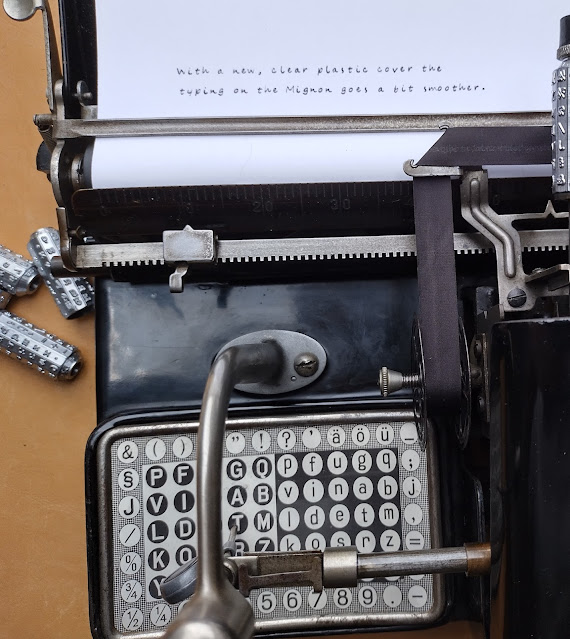The Intertype below was spotted at a local printing-museum.
Sunday, July 28, 2024
Sighting of an Intertype with full keyboard
Friday, July 19, 2024
New typeshuttles for the Hammond - steps forward, steps back
It's a lot like regular new-product development. Steps forward, and a step back (or two). Forward was that printing the strip with DLP resin technology gave incredibly crisp letters on the strip.
Wednesday, July 17, 2024
Re-assembled carriage of Mignon 4 index typewriter
Not the most readable typeface, I'll admit - fun to be able to use though :)
A few more pictures would have helped find the spot for the small line-feed helper-lever, but it went together again and now all very clean.
Still have to manufacture two new springs for pressing the ruler onto the platen. Turns out that those springs are essential to keep the paper properly onto the platen, to solve the ghosting or shadowing.
Sunday, July 14, 2024
AEG Mignon typewriter with Rheinmetall logo
In the process of giving a Mignon index typewriter a thorough cleaning, the carriage was taken apart. This particular Mignon was made by AEG sometime in the late 1920s and in keeping with the overall heft of the machine, the carriage frame is cast iron.
There is a shield with the machine serial-number riveted to the casting and the middle-tie has lettering "SMa" over the number 6001. The 6001 may refer to the pattern or drawing-number, the meaning of "SMa" could be a simple as "SchreibMAschine" or typewriter.
Castings sometimes also have a mark of the foundry, when not manufactured by the typewriter-factory itself and sub-contracted out. This casting indeed does have such a mark. Unexpectedly, the logo on this casting is the Rheinmetall logo.
Clearly marked with the circle and inverted quarter-circles, as also used strikingly on the front-panel of their typewriters of the same period.
(wordmark image from a user manual on The Classic Typewriter Page)
The factories of both companies were also 'next door' to each other, the Rheinmetall site at Sömmerda is not too far away from the AEG typewriter-factory in Erfurt.
It's thus likely that in the 1920s Rheinmetall not only made their own typewriters, but was also a parts supplier to AEG, the later Olympia.
Sunday, July 7, 2024
Refreshing a Mignon typewriter character field or keyboard
The 'keyboard' or character-field of a Mignon index typewriter is where the desired character is selected with the pointer. This map or field is a curved plate, covered with clear celluloid. After 90 years or so, on some key-boards, the celluloid is not so clear anymore - and what was worse on this specimen; the old plastic started to crack and crumble.
Because it was falling apart and catching the index-pointer, this 'keyboard' was taken apart for replacing the clear plastic with new. There are a great many tabs around the rim; after carefully bending these open, the stack of a fibre backing-plate, aluminium sheet with the characters and the celluloid top-sheet can be taken out.
Friday, July 5, 2024
New typeshuttles for the Hammond - more iterations
It's getting there.
It's iterative development, almost every prototype uncovered something new to improve or a new fault-mode.
Now at version 14 of the reproduction typeshuttle, the mechanical function and interaction with the machine is fine. The design is now at the stage where precision of the type itself needs improving. The rapid prototyping strips can't create proper stems of e.g. the 'p' or 'h', as can be seen from the type-sample.
Original at the left, reproduction at the right.












.jpg)








